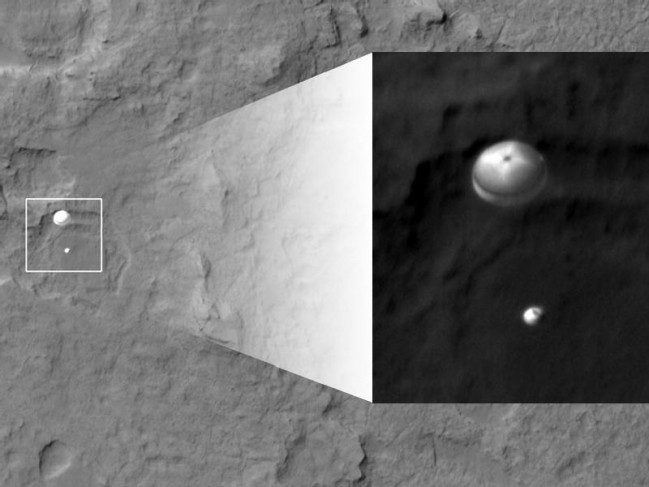
Scientists and engineers at JPL have Mount Sharp in their sites. It’s no ordinary mountain — it’s situated on Mars. The 5,000 meter high mountain is home to exposed layers of some promising sedimentary rocks, which hold clues to Mars’ geologic, and perhaps biological, history. Unfortunately, Mount Sharp is 10K away from the current home of the Curiosity rover. So, at a top speed of around 100 meters per day it will take Curiosity until the fall of 2013 to reach its destination.
[div class=attrib]From the New Scientist:[end-div]
NASA’S Curiosity rover is about to have its cake and eat it too. Around September, the rover should get its first taste of layered sediments at Aeolis Mons, a mountain over 5 kilometres tall that may hold preserved signs of life on Mars.
Previous rovers uncovered ample evidence of ancient water, a key ingredient for life as we know it. With its sophisticated on-board chemistry lab, Curiosity is hunting for more robust signs of habitability, including organic compounds – the carbon-based building blocks of life as we know it.
Observations from orbit show that the layers in Aeolis Mons – also called Mount Sharp – contain minerals thought to have formed in the presence of water. That fits with theories that the rover’s landing site, Gale crater, was once a large lake. Even better, the layers were probably laid down quickly enough that the rocks could have held on to traces of microorganisms, if they existed there.
If the search for organics turns up empty, Aeolis Mons may hold other clues to habitability, says project scientist John Grotzinger of the California Institute of Technology in Pasadena. The layers will reveal which minerals and chemical processes were present in Mars’s past. “We’re going to find all kinds of good stuff down there, I’m sure,” he says.
Curiosity will explore a region called Glenelg until early February, and then hit the gas. The base of the mountain is 10 kilometres away, and the rover can drive at about 100 metres a day at full speed. The journey should take between six and nine months, but will include stops to check out any interesting landmarks. After all, some of the most exciting discoveries from Mars rovers were a result of serendipity.
[div class=attrib]Read the entire article following the jump.[end-div]
[div class=attrib]Image: Base of Mount Sharp, Mars. Courtesy of Credit: NASA/JPL-Caltech/MSSS.[end-div]
 NASA is advertising its upcoming space tourism trip to Saturn’s largest moon Titan with this gorgeous retro poster.
NASA is advertising its upcoming space tourism trip to Saturn’s largest moon Titan with this gorgeous retro poster.



 NASA’s latest spacecraft to visit Mars, the Mars Reconnaissance Orbiter, has made some stunning observations that show the possibility of flowing water on the red planet. Intriguingly, repeated observations of the same regions over several Martian seasons show visible changes attributable to some kind of dynamic flow.
NASA’s latest spacecraft to visit Mars, the Mars Reconnaissance Orbiter, has made some stunning observations that show the possibility of flowing water on the red planet. Intriguingly, repeated observations of the same regions over several Martian seasons show visible changes attributable to some kind of dynamic flow.